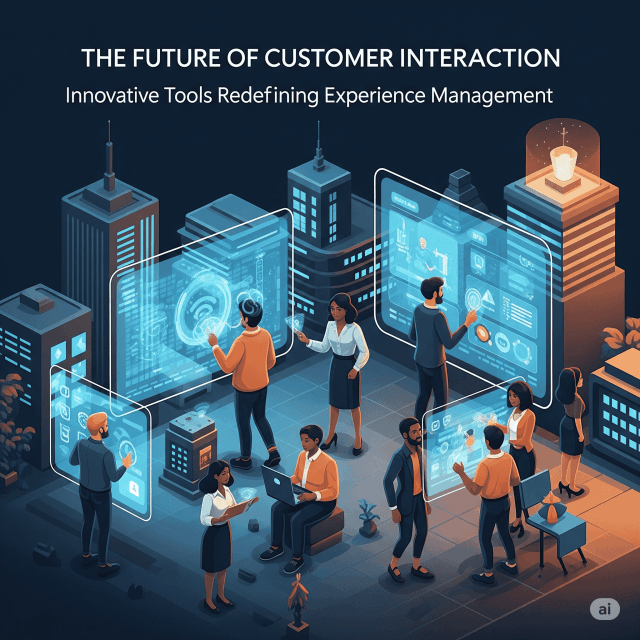In the fast-evolving landscape of customer interaction, businesses are continually exploring innovative tools that enhance experience management. As technology advances and consumer preferences shift, organizations must adapt to sustain engagement and loyalty. This article explores the emerging tools and trends poised to redefine how businesses interact with their customers.
1. The Rise of Artificial Intelligence and Chatbots
One of the most significant advancements in customer interaction is the integration of artificial intelligence (AI). AI-driven chatbots have become prevalent across various platforms, capable of handling customer inquiries in real-time. These tools not only provide immediate responses but also learn from interactions to improve their effectiveness.
Benefits:
- 24/7 Availability: AI chatbots can operate outside standard business hours, providing support whenever customers need it.
- Personalization: By analyzing customer data, chatbots can offer tailored recommendations and solutions.
- Cost Efficiency: Automating routine inquiries allows human agents to focus on more complex issues, optimizing resources.
Future Prospects:
As AI technology continues to evolve, we can expect chatbots to become increasingly sophisticated, capable of understanding and processing natural language more effectively, enhancing the overall customer experience.
2. Omnichannel Communication
Today’s consumers interact with brands across multiple channels—social media, email, websites, and mobile apps. The ability to provide a seamless experience across these platforms is crucial. Omnichannel communication tools integrate interactions, allowing customers to switch between channels without losing context.
Benefits:
- Consistency: Customers receive uniform messaging, leading to a cohesive brand experience.
- Enhanced Engagement: Tailored interactions driven by data from various platforms can improve customer satisfaction.
- Better Analytics: Centralized data collection helps businesses understand customer preferences and behavior more comprehensively.
Future Prospects:
With advancements in integration technologies, the future may see even more refined omnichannel solutions that harness real-time data analytics to personalize interactions instantly.
3. Predictive Analytics
Predictive analytics is revolutionizing customer interaction by using historical data to forecast future behaviors. Businesses can leverage insights gleaned from customer interactions to anticipate needs and tailor their strategies accordingly.
Benefits:
- Proactive Engagement: Understanding potential customer needs allows companies to reach out with solutions before issues arise.
- Customer Retention: By predicting churn, companies can implement interventions to retain at-risk customers.
- Personalized Marketing: Tailored campaigns based on predictive data can significantly improve conversion rates.
Future Prospects:
As machine learning algorithms improve, predictive analytics will become more accurate, enabling businesses to not only react but also stay ahead of customer expectations.
4. Augmented Reality (AR) and Virtual Reality (VR)
The adoption of AR and VR technologies in customer interaction is a game changer, especially in sectors like retail and real estate. These immersive technologies offer unique ways for customers to engage with products and services.
Benefits:
- Enhanced Experience: Customers can visualize products in their own environments, making purchasing decisions easier.
- Increased Engagement: Interactive experiences can lead to higher customer satisfaction and loyalty.
- Competitive Edge: Early adopters stand out in a crowded market by offering unique experiences.
Future Prospects:
As AR and VR technologies become more accessible, we can expect more businesses to incorporate these tools into their customer interaction strategies, enhancing both engagement and sales.
5. Voice Technology
Voice-activated technology, such as smart speakers and voice assistants, is becoming increasingly prevalent in customer interaction. Businesses are exploring how to leverage this technology to create voice-enabled customer experiences.
Benefits:
- Convenience: Customers can interact with brands hands-free, allowing for multitasking and ease of access.
- Accessibility: Voice technology can cater to individuals varying abilities, making it an inclusive option for customer interaction.
Future Prospects:
As voice recognition technology improves, we can expect a rise in voice commerce and voice-driven customer care solutions, transforming traditional interaction models.
Conclusion
The future of customer interaction is being shaped by innovative tools designed to enhance experience management. From AI-powered chatbots and omnichannel communication to predictive analytics, AR/VR technologies, and voice-enabled interactions, businesses are redefining their approaches to customer service. Embracing these advancements will be critical for organizations seeking to maintain relevance and foster customer loyalty in an increasingly competitive landscape.
As we move forward, the focus will continue to be on personalization, efficiency, and engagement, ensuring that customer experiences are not only satisfactory but also memorable. By investing in these innovative tools and strategies, companies can position themselves at the forefront of the customer interaction revolution.









